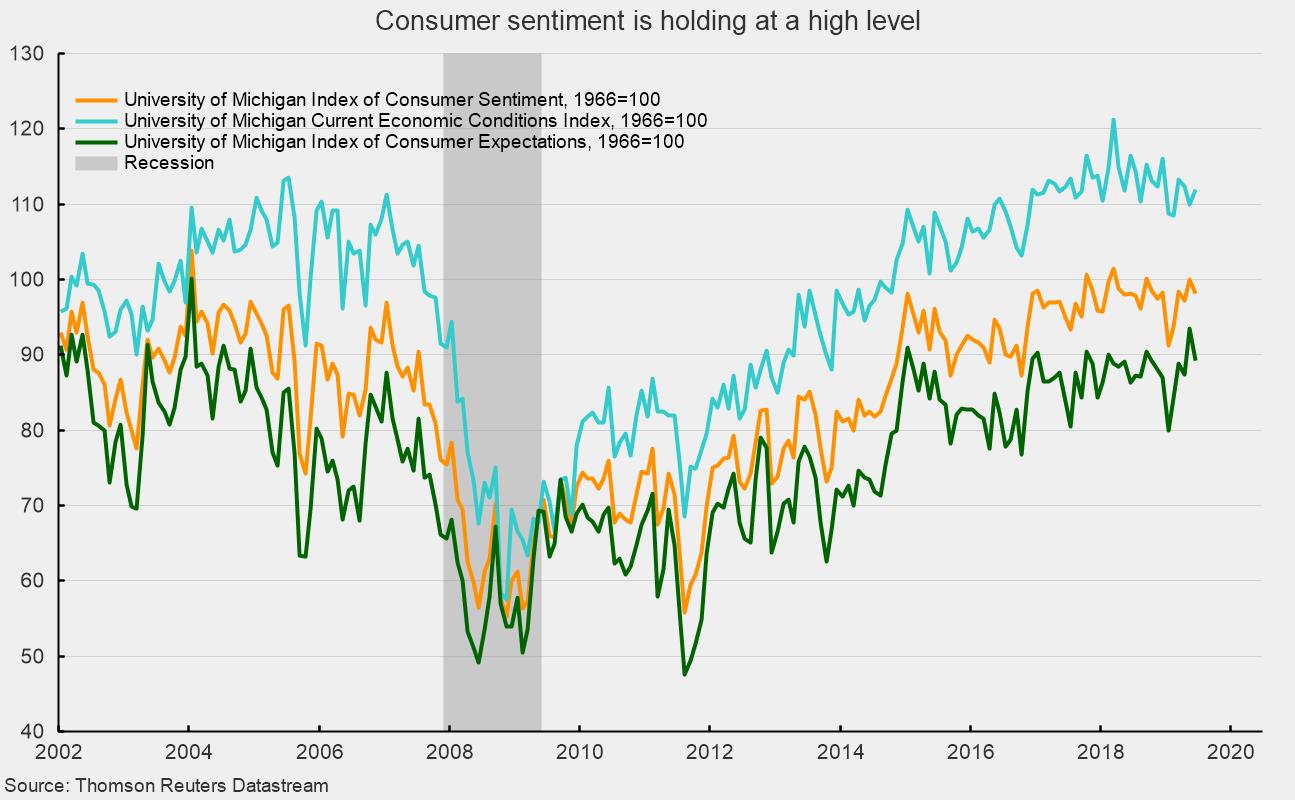Sentiment Fell in June Despite Gains in Income and Spending in May
The final June results from the University of Michigan Surveys of Consumers show overall consumer sentiment fell slightly from the final May result. Consumer sentiment decreased to 98.2 in June, down from 100.0 in May, a 1.8 percent decline (see chart). From a year ago, the index is unchanged. Despite the slight decline for the month, sentiment is holding at very favorable levels.
The two sub-indexes had opposing performances in June. First, the current-economic-conditions index rose to 111.9 from 110.0 in May (see chart). That is a 1.7 percent gain for the month but a 3.9 percent decrease from June 2018.
The second sub-index — that of consumer expectations, one of the AIER leading indicators — fell 4.5 percent for the month but still showed a 3.5 percent gain from the prior year. The index came in at 89.3 in June versus 93.5 in May. According to the report:
June’s small overall decline was entirely due to households with incomes in the top third of the distribution, who more frequently mentioned the negative impact of tariffs, cited by 45%, up from 30% last month. Most of the June slippage was concentrated in prospects for the national economy, with the unemployment rate expected to inch upward instead of drifting downward in the year ahead. Interest rates were anticipated to rise by the fewest respondents in six years, and declines in mortgage rates have begun to have a positive impact on home buying. While more negative trade news will act to decrease consumer spending, the persistent overall strength in consumer confidence is still consistent with growth of real personal consumption expenditures by 2.5% during the next twelve months.
Personal income rose 0.5 percent in May, according to data from the Bureau of Economic Analysis. The gain in personal income consisted in part of a 0.2 percent increase in wages and salaries. Wages and salaries account for about half of personal income. Supplements to wages and salaries (primarily employer contributions to pension and insurance funds and government social-insurance programs) account for another 12 percent of personal income and also posted a 0.2 percent rise in May. Proprietors’ income jumped 0.8 percent for the month following a 0.4 percent gain while income on assets (interest and dividends) surged 1.6 percent. Personal tax payments rose 0.8 percent, leaving disposable income with a gain of 0.5 percent. Adjusting for price changes, real disposable income rose 0.3 percent in May, up from a 0.1 percent rise in April.
On the spending side, total personal consumption expenditures (PCE) rose 0.4 percent in May following a 0.6 percent increase in April. Among the components, durable goods rose 1.7 percent while nondurable-goods spending fell 0.1 percent. Spending on services increased 0.4 percent for the month. After adjusting for price changes, real PCE increased 0.2 percent as a 1.6 percent gain in real durable-goods spending was accompanied by a 0.2 percent drop in real nondurable-goods spending and a 0.2 percent rise in real services spending.
The personal savings rate held at 6.1 percent of disposable income for the second month in a row. A more comprehensive measure of savings is available in the quarterly flow-of-funds data from the Federal Reserve. That measure has typically shown a higher savings rate compared to the measure in the monthly personal-income release.
The price indexes from the report on personal income and spending are the primary measures followed by the Federal Reserve. The total PCE price index increased 0.2 percent in May as durable-goods prices rose 0.1 percent, nondurable-goods prices rose 0.1 percent, and services prices increased 0.2 percent. The PCE price index excluding food and energy rose 0.2 percent for the month.
Over the past year, the PCE price index is up 1.5 percent, down from the 1.6 percent in the prior month. The core PCE index, which excludes food and energy prices, is up 1.6 percent from a year ago. That measure has been running at or below 2 percent since 2012.
Overall, consumer sentiment remains at broadly favorable levels, supported by a robust labor market, income gains, and record-high net worth. However, rising tariffs and erratic trade policy are starting to impact attitudes. The crucial questions are whether consumers will alter spending and whether businesses will alter hiring and investment in the face of tariffs, actual and threatened.






